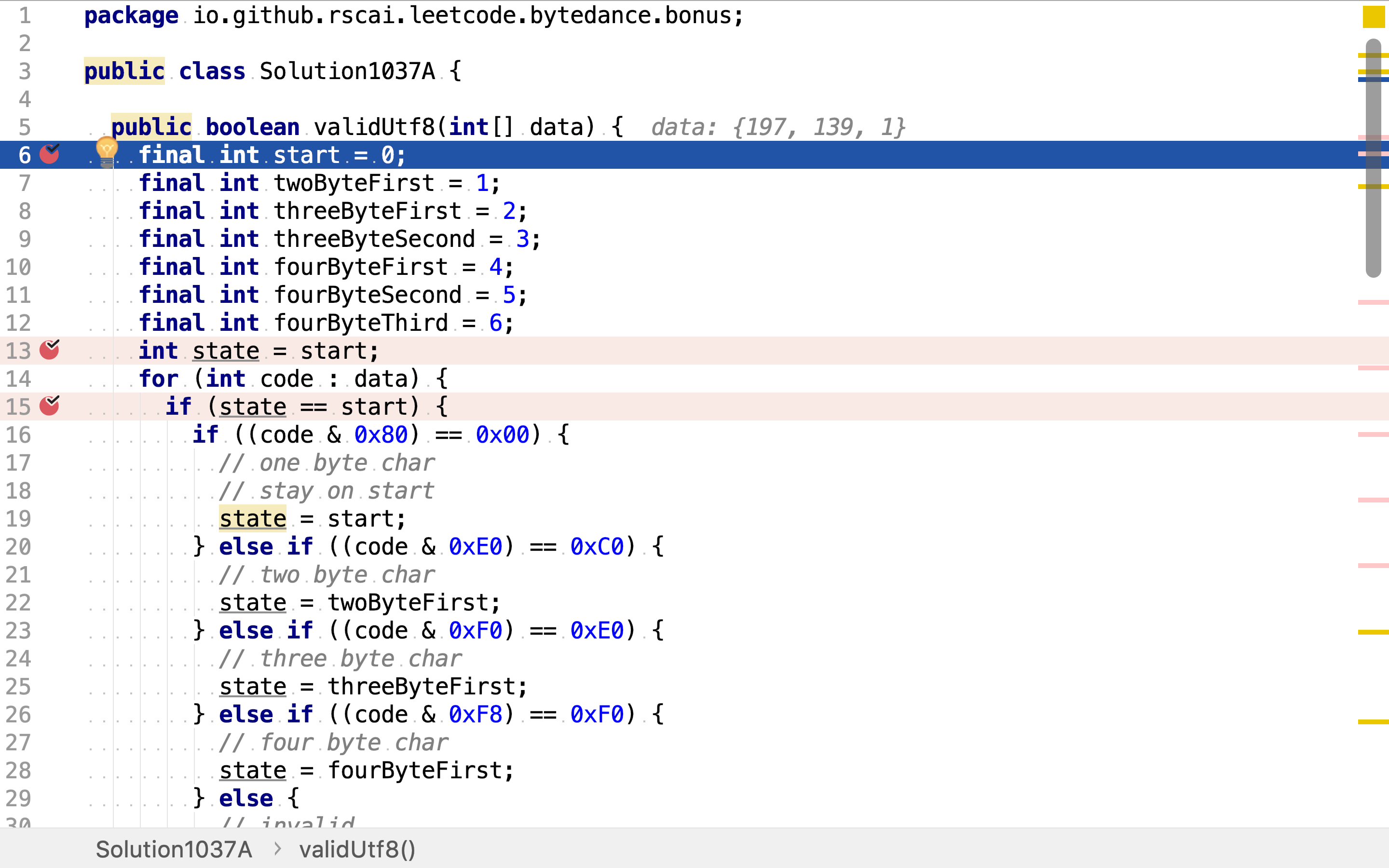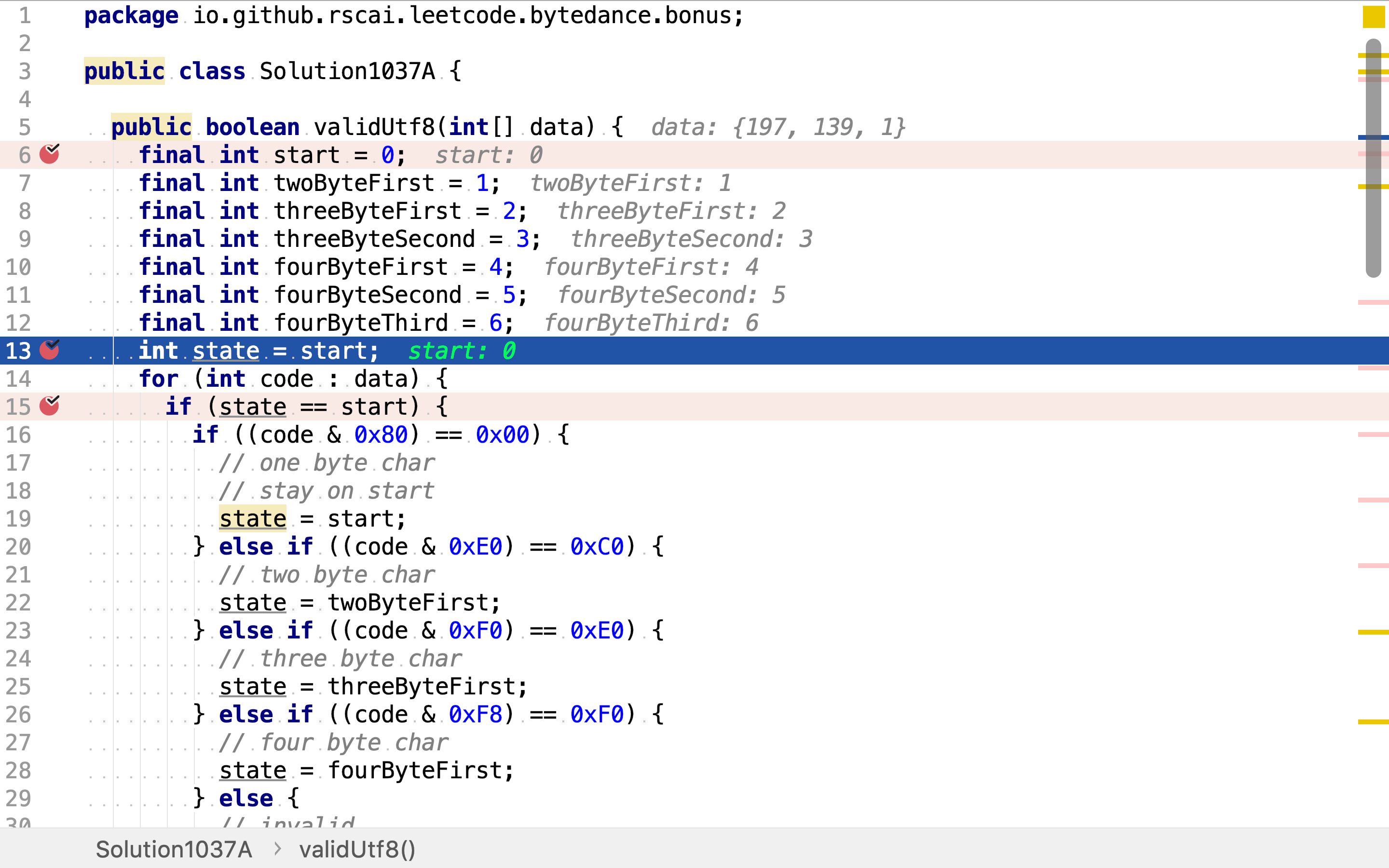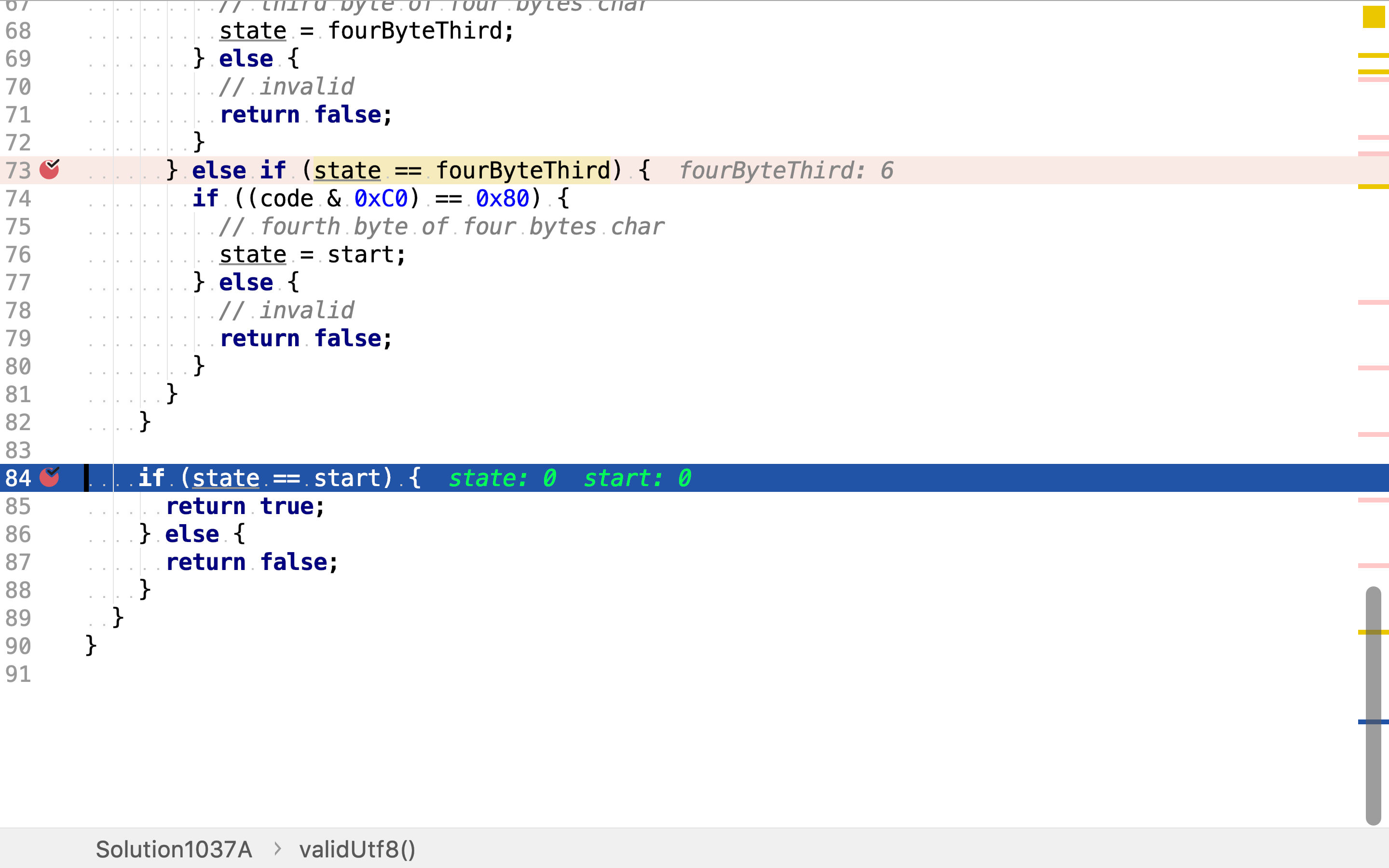UTF-8 编码验证
题目
UTF-8 中的一个字符可能的长度为 1 到 4 字节,遵循以下的规则:
- 对于 1 字节的字符,字节的第一位设为0,后面7位为这个符号的unicode码。
- 对于 n 字节的字符 (n > 1),第一个字节的前 n 位都设为1,第 n+1 位设为0,后面字节的前两位一律设为10。剩下的没有提及的二进制位,全部为这个符号的unicode码。
这是 UTF-8 编码的工作方式:
Char. number range | UTF-8 octet sequence (hexadecimal) | (binary) --------------------+--------------------------------------------- 0000 0000-0000 007F | 0xxxxxxx 0000 0080-0000 07FF | 110xxxxx 10xxxxxx 0000 0800-0000 FFFF | 1110xxxx 10xxxxxx 10xxxxxx 0001 0000-0010 FFFF | 11110xxx 10xxxxxx 10xxxxxx 10xxxxxx给定一个表示数据的整数数组,返回它是否为有效的 utf-8 编码。
注意:
输入是整数数组。只有每个整数的最低 8 个有效位用来存储数据。这意味着每个整数只表示 1 字节的数据。
示例 1:
data = [197, 130, 1], 表示 8 位的序列: 11000101 10000010 00000001. 返回 true 。 这是有效的 utf-8 编码,为一个2字节字符,跟着一个1字节字符。示例 2:
data = [235, 140, 4], 表示 8 位的序列: 11101011 10001100 00000100. 返回 false 。 前 3 位都是 1 ,第 4 位为 0 表示它是一个3字节字符。 下一个字节是开头为 10 的延续字节,这是正确的。 但第二个延续字节不以 10 开头,所以是不符合规则的。
确定有限状态机法
确定有限状态机是解决正则语言、编码检验解柝的一个很有利的数学模型。
确定有限状态自动机
在计算理论中,确定有限状态自动机或确定有限自动机(英语:deterministic finite automaton, DFA)是一个能实现状态转移的自动机。对于一个给定的属于该自动机的状态和一个属于该自动机字母表 的字元,它都能根据事先给定的转移函式转移到下一个状态(这个状态可以是先前那个状态)。
基础概念
定义
确定有限状态自动机 是由
- 一个非空有限的状态集合
- 一个输入字母表 (非空有限的字元集合)
- 一个转移函式 (例如: )
- 一个开始状态
- 一个接受状态的集合
所组成的5-元组。因此一个DFA可以写成这样的形式: 。
工作方式(非正式的语意)
确定有限状态自动机从起始状态开始,一个字元接一个字元地读入一个字串 (这里的 指示Kleene星号算子。),并根据给定的转移函式一步一步地转移至下一个状态。在读完该字串后,如果该自动机停在一个属于F的接受状态,那么它就接受该字串,反之则拒绝该字串。
扩充转移函式
为了在保证严谨的前提下,方便地叙述关于DFA的内容,我们定义如下扩充的转移函式:。
- 其中是自动机从状态q顺序读入字串w后达到的状态
- 扩充转移函式递回的定义为:
工作方式(正式的语意)
对于一个确定有限状态自动机 ,如果 ,我们就说该自动机接受字串w,反之则表明该自动机拒绝字串w。
被一个确定有限自动机接受的语言(或者叫「被辨识的语言」)定义为: 也就是由所有被接受的字串组成的集合。
参考
针对本题,定义:
- 一个非空有限的状态集合
{start, twoByteFirst, threeByteFirst, threeByteSecond, fourByteFirst, fourByteSecond, fourByteThird} - 一个轮入字母表
{0xxxxxxx, 110xxxxx, 1110xxxx, 11110xxx, 10xxxxxx} - 一个转移函数
| State | 0xxxxxxx | 110xxxxx | 1110xxxx | 11110xxx | 10xxxxxx |
|---|---|---|---|---|---|
| start | start | twoByteFirst | threeByteFirst | fourByteFirst | |
| twoByteFirst | start | ||||
| threeByteFirst | threeByteSecond | ||||
| threeByteSecond | start | ||||
| fourByteFirst | fourByteSecond | ||||
| fourByteSecond | fourByteThird | ||||
| fourByteThird | start |
- 一个开始状态
start - 一个接受状态的集合
{start}
举个例子,轮入整数序列[197, 130, 1], 表示 8 位的序列: 11000101 10000010 00000001。
- state初始为start;
- 输入第一个8位值
11000101,其符合110xxxxx,所以转移状态至twoByteFirst - 输入第二个8位值
10000010,其符合10xxxxxx,所以转移状态至start - 输入第三个8位值
00000001,其符合0xxxxxxx,所以保持状态为start
最终状态停留在start,属于接受状态集合,所以该整数序列是有效的UTF-8编码。
代码实现
将所有状态值都定义为常量,

状态初始化为start,

使用for循环逐一输入整数,驱动「确定有限状态机」

最后,判断状态是否为可接受状态。

复杂度分析
时间复杂度
本演算法只遍历了一遍整数序列,所以时间复杂度为。
空间复杂度
使用了一个变量state,所以空间复杂度为。